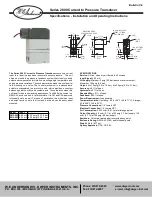
Fig. 2
Microphone plug wiring
4. Remove the retaining screw
5. Unscrew the housing from the pin receptacle body
6. Loosen the two cable clamp retainer screws.
7. Feed the microphone cable through the housing, knurled ring and washer as
shown Fig. 2.
8. The wires must now be soldered to the pins as indicated in the above wiring
tables. If a vise or clamping tool is available it should be used to hold the pin
receptacle body during the soldering operation, so that both hands are free to
perform the soldering. If a vise or clamping tool is not available, the pin
receptacle body can be held in a stationary position by inserting it into the
microphone jack of the front panel. The numbers of the pins of the microphone
plug are shown in Fig. 3, as viewed from the back of the plug. Before
soldering the wire to the pins, pre-tin the wire receptacle of each pin of the
plug.
Specifications
GENERAL
Frequency Range
28.065 to 28.505 MHz
Frequency Control
Phase Lock Loop (PLL) synthesizer.
Frequency Tolerance
0.005%
Frequency Stability
0.001%
Operating Temperature
Range
-30
°
C to +50
°
C.
Microphone
Plug-in dynamic; with push-to-talk switch and
coiled cord.
Input Voltage
13.8V DC nominal, 15.9V max, 11.7V min.
(Positive or negative ground).
Transmit:
AM full mod., 2.2A.
Receiver:
Squelched, 0.3A.
Maximum Audio output, 0.7A.
Size
2-3/8” (H) x 7-7/8” (W) x 9-1/4” (D).
Weight 5
Ibs.
Antenna Connector
UHF, SO239
Meter
Illuminated; indicates relative output power,
received signal strength.
TRANSMITTER
Power output
AM/FM, High-7 watts
Low-3.5 watts
Modulation High-and
low-level Class B, Amplitude
Modulation: AM. Variable capacitance
Frequency Modulation: FM.
Spurious Emissions
60 dB
Frequency Response
AM and FM: 450 to 2500 Hz.
Output Impedance
50 ohms, unbalanced
Output Indicators
Meter shows relative RF output power and
SWR. Transmit LED glows red when
transmitter is in operation.
- 2 -
- 13 -


























